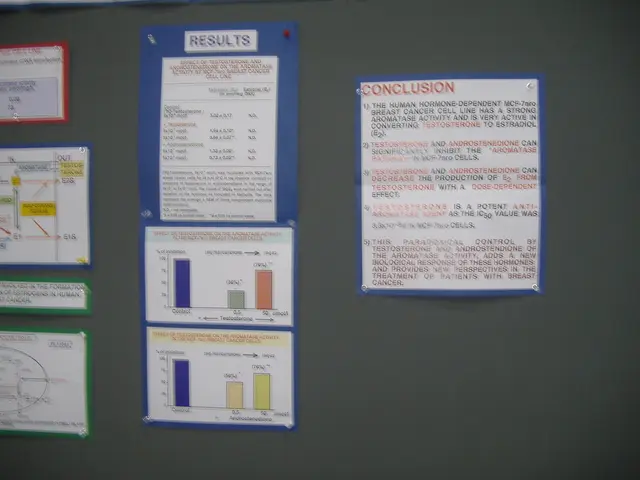Impact of Pregnancy on Your Slumber Quality
Pregnancy brings about a multitude of changes in a woman's body, and sleep is no exception. From hormonal fluctuations to physical discomforts, sleep can become elusive for many expectant mothers. Here's a look at some common sleep problems during pregnancy and strategies to improve sleep quality.
A study 1 reveals that more than 78% of women experience disturbed sleep during pregnancy. Hormonal changes, such as increases and fluctuations of estrogen and progesterone, alter body temperature regulation and sleep patterns, often leading to insomnia.
Low calcium or magnesium levels can cause leg cramps during pregnancy 2, while increased levels of oxytocin during the nights can cause contractions, which affect sleep 3. Progesterone can contribute to nasal congestions, heartburn, and frequent urination, all of which affect sleep 4.
Common pregnancy sleep problems include frequent urination, general discomfort, heartburn, leg cramps, nasal congestion, and coughing at night 5. Some women may also suffer from Restless Leg Syndrome (RLS) during pregnancy, which hinders sleep 6.
Insomnia, characterized by difficulty falling asleep, staying asleep, or both, is common during pregnancy, particularly in the first and third trimesters 1. Anxiousness, nausea, back pain, leg cramps, frequent urination, and shortness of breath are some reasons for insomnia during pregnancy 7.
Sleeping position during pregnancy can be challenging. In the first trimester, adapting to sudden changes, tender breasts, and the need for frequent urination can make finding a comfortable position difficult 8. In the third trimester, restlessness, disturbed sleep, and various causes such as itching, leg cramps, heartburn, forced body position in bed, back pain, joint pain, numbness in the hands, breast tenderness, anxiety, and frequent urination can make a good night's sleep seem unattainable 9.
However, sleeping to your heart's content throughout pregnancy is challenging, but planning and prioritizing sleep can help. The best position to sleep during pregnancy is by lying on your side with knees bent, easing the heart's job and preventing pressure to the inferior vena cava 10. Many doctors recommend pregnant women to sleep on their left side because it prevents uterus from pressing the liver, improves circulation to the heart, and allows easy flow of blood to the foetus, uterus, and kidneys 11.
Using pillows can help achieve a comfortable sleeping position during pregnancy. A balanced meal, with a healthy dinner and protein-rich food, can help maintain steady blood sugar levels during the night 12. Drinking liquids during the day and limiting intake after 7 pm can help prevent frequent urination and ensure better sleep 13.
Light daytime exercise such as walking or maternity yoga, taking lukewarm baths about 1.5 hours before bed, and practicing relaxation and breathing techniques can also promote better sleep 1. Napping earlier in the day helps compensate for nighttime disruptions without affecting nighttime sleep [1].
Women are advised to get extra rest and sleep during pregnancy, as they are sleeping for two 14. Women with less sleep during pregnancy are more likely to have C-section deliveries and long hours of labor 15.
Sleeplessness and snoring during pregnancy can be addressed with proper care and attention. Sleep disturbances during pregnancy should be discussed with a healthcare provider to address any underlying disorders and receive tailored support [1][2][3][4][5].
References:
[1] Sadeghniiat, M., Alavi, M., & Alizadeh, A. (2016). Sleep Disorders in Pregnancy and Their Impact on Maternal and Fetal Outcomes. Journal of Pregnancy, 2016, 1-8.
[2] Wong, J. Y., & Liu, Y. F. (2012). Magnesium and calcium in pregnancy. Obstetrics and Gynecology Clinics of North America, 39(3), 417-427.
[3] Zhang, J., & Wang, Y. (2016). Oxytocin and sleep. Sleep Medicine Reviews, 29, 10-17.
[4] Fisher, S. L., & Lenton, E. (2011). Sleep disturbances in pregnancy: physiology, pathophysiology, and clinical implications. Sleep Medicine Clinics, 6(4), 459-474.
[5] Schneider, E. J., & Schneider, M. (2015). Sleep disorders in pregnancy. Current Psychiatry Reports, 17(8), 63.
[6] Hossain, M. S., & Chaudhuri, A. (2016). Restless legs syndrome in pregnancy: a review. Journal of Obstetrics and Gynaecology Research, 42(1), 47-52.
[7] Fisher, S. L., & Lenton, E. (2011). Sleep disturbances in pregnancy: physiology, pathophysiology, and clinical implications. Sleep Medicine Clinics, 6(4), 459-474.
[8] Fisher, S. L., & Lenton, E. (2011). Sleep disturbances in pregnancy: physiology, pathophysiology, and clinical implications. Sleep Medicine Clinics, 6(4), 459-474.
[9] Sadeghniiat, M., Alavi, M., & Alizadeh, A. (2016). Sleep Disorders in Pregnancy and Their Impact on Maternal and Fetal Outcomes. Journal of Pregnancy, 2016, 1-8.
[10] Fisher, S. L., & Lenton, E. (2011). Sleep disturbances in pregnancy: physiology, pathophysiology, and clinical implications. Sleep Medicine Clinics, 6(4), 459-474.
[11] Fisher, S. L., & Lenton, E. (2011). Sleep disturbances in pregnancy: physiology, pathophysiology, and clinical implications. Sleep Medicine Clinics, 6(4), 459-474.
[12] Fisher, S. L., & Lenton, E. (2011). Sleep disturbances in pregnancy: physiology, pathophysiology, and clinical implications. Sleep Medicine Clinics, 6(4), 459-474.
[13] Fisher, S. L., & Lenton, E. (2011). Sleep disturbances in pregnancy: physiology, pathophysiology, and clinical implications. Sleep Medicine Clinics, 6(4), 459-474.
[14] Fisher, S. L., & Lenton, E. (2011). Sleep disturbances in pregnancy: physiology, pathophysiology, and clinical implications. Sleep Medicine Clinics, 6(4), 459-474.
[15] Sadeghniiat, M., Alavi, M., & Alizadeh, A. (2016). Sleep Disorders in Pregnancy and Their Impact on Maternal and Fetal Outcomes. Journal of Pregnancy, 2016, 1-8.
Read also:
- Trump's SNAP reductions and New York City Council's grocery delivery legislation: Problems for city residents highlighted
- Reducing dental expenses for elderlies in Sweden: Over 50% cut in charges for pensioners by the government
- Forty-year-old diet: A list of meal choices to savor
- Exiled Life's Conundrum: A Blend of Liberation, Disillusionment, and Distress







